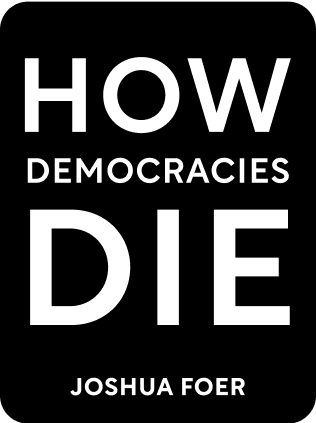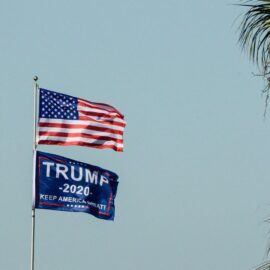

This article is an excerpt from the Shortform book guide to "How Democracies Die" by Steven Levitsky and Daniel Ziblatt. Shortform has the world's best summaries and analyses of books you should be reading.
Like this article? Sign up for a free trial here .
How do political parties choose their candidates for president? How has the presidential nomination process changed over the years?
Before the 1970s, a candidate had to win over party insiders in the so-called “smoke-filled rooms” of party conventions and caucuses to even have a chance of winning a major-party nomination. This old party system began to change during the 1968 Democratic National Convention in Chicago when party delegates entered the convention with no clear consensus on who the nominee should be.
In this article, we’ll explore the evolution of the presidential nomination process in the United States.
The Demise of the Old Party System
Levitsky and Ziblatt argue that this old party system began to decay in the 1970s, when both the Democratic and Republican parties changed their rules governing presidential nominations. They date the beginning of this process to the turbulent events of the 1968 Democratic National Convention in Chicago.
Party delegates, deeply divided over the Vietnam War, entered the convention with no clear consensus on who the nominee should be, as no candidate had secured a majority of delegates during the primaries. At the convention, party insiders installed Vice President Hubert Humphrey—a candidate perceived as being pro-war because he served in the incumbent Lyndon B. Johnson administration—as the nominee, despite him not having competed in any primaries. The authors contend that rank-and-file delegates, many of whom were bitterly opposed to the war, took Humphrey’s nomination as a deep betrayal.
But this was to be the last such presidential nomination carried out in this fashion. At a time when people were taking to the streets to protest the Vietnam War and popular candidates like the recently slain Robert F. Kennedy had helped open the door to a more representative form of party politics, the installation by a handful of party insiders of Humphrey at the top of the ticket was no longer considered acceptable.
According to the authors, the circumstances under which Humphrey was nominated dealt a crushing blow to the old party boss system and prompted calls for reform.
| Hubert Humphrey: Party Reformer? Although Levitsky and Ziblatt describe the perception of Humphrey in 1968 to be that of a stodgy political insider, he actually spent much of his career fighting for the expansion of political representation and for the enfranchisement of politically powerless minorities—often despite bitter opposition from Democratic Party insiders. A staunch liberal, Humphrey was one of the party’s early pioneers in the fight for civil rights. At the 1948 Democratic National Convention, Humphrey shocked the political world (and outraged Southern Democrats) by delivering a floor speech in which he called for the Democratic Party to abandon the cause of “states’ rights” (by which Southern Democrats rationalized the disenfranchisement and segregation of African-Americans) and instead embrace the cause of human rights. The reaction from the South’s party leaders was swift and fierce. Southern delegates bolted the convention and nominated their own candidate, Strom Thurmond of South Carolina, under the banner of the States’ Rights Democratic Party. |
The McGovern-Fraser Commission
In response to the chaos of the 1968 convention, the McGovern-Fraser Commission—a panel convened by the national Democratic Party—shifted the party to a system of state-level primaries for the 1972 presidential election. Instead of state bosses and other party elites choosing the party’s nominee, rank-and-file party members would directly elect delegates to the national convention, giving voters direct control over the presidential nomination process for the first time. Similar rules were adopted by the Republican Party before the 1972 presidential election.
Levitsky and Ziblatt argue that these reforms marked the death knell of the old gatekeeper system. Anyone could now run for the nomination and completely circumvent the traditional gatekeepers—opening the door to outsiders and extremists to capture major-party nominations.
One of the first “outsider” candidates to take advantage of the new nomination process was U.S. Senator George McGovern—one of the co-chairs of the 1972 McGovern-Fraser Commission. McGovern used his mastery of the new primary system to win the Democratic Party nomination in 1972. An anti-Vietnam War candidate long considered to be on the far left of the Democratic Party, McGovern was precisely the kind of candidate that would have been highly unlikely to be nominated under the old system. He went on to lose in a historic landslide to incumbent Richard Nixon in the 1972 general election.
| Extremist Candidates Under the Old Party System Levitsky and Ziblatt’s argument that the old, pre-1970s party system was successful at keeping insurgent outsiders from winning presidential nominations doesn’t quite stand up to scrutiny. For example, in 1896, 1900, and 1908, the fiery populist orator William Jennings Bryan won the Democratic nomination despite strong opposition from party establishment figures. And in 1964, U.S. Senator Barry Goldwater—a figure who contemporary politicos believed was too far to the right to be nominated and win—successfully captured the Republican nomination in the teeth of strong opposition from mainstream party leaders like Nelson Rockefeller and Richard Nixon. Both Bryan and Goldwater did, however, go down to landslide defeats in their respective general election campaigns—suggesting that perhaps party leaders were prescient in trying to block their nominations. |
The New Party Nomination System
At first, Levitsky and Ziblatt argue, the new nomination system appeared to work quite well. Party insiders may no longer have been in direct control of the delegates on the convention floor, but the parties were initially successful at defeating the campaigns of insurgent outsiders. Such candidates—like Pat Robertson and Steve Forbes, who ran for the GOP nomination in 1988 and 2000, respectively—generated lots of enthusiasm and media coverage, but they fell far short of party presidential nominations.
(Shortform note: Across two presidential runs in 1996 and 2000, Forbes spent $69 million of his personal fortune. Despite this largesse, the billionaire publishing executive won zero primaries during either of his failed campaigns and secured only 21 delegates. At over $3.2 million-per-delegate, Forbes may have gotten the worst return on investment of any presidential candidate in the modern era.)
Vulnerability to Celebrities
Still, Levitsky and Ziblatt contend that bids like Robertson’s and Forbes’s should have been seen as early warning signs of just how vulnerable the new system could be to hostile takeovers by outsiders with lots of money and high name recognition—in other words, celebrities. These candidates earned a great deal of coverage from the media, which greatly boosted their already-considerable national profiles.
Before running, Robertson was already a famous televangelist, who boasted a built-in audience of millions of loyal viewers. Forbes, meanwhile, was a famous businessman with billions of dollars of his own money to spend—he could bypass traditional party donors, because he didn’t need to raise money from them.
The authors also point to the rise of alternative media like Twitter and Facebook, as well as explicitly ideological and partisan media (especially on the conservative side of American politics) as forces that served to weaken the parties as institutions. Through these media channels, they argue, an outsider celebrity candidate could get their message across far more easily and communicate directly with their supporters. Media and technology, like the nomination process itself, had become democratized.
All of these factors were in place by 2015, when Donald Trump launched his bid for the Republican nomination. They were to give his campaign, at first considered a longshot, a decisive advantage and prove once and for all that the old system of party gatekeeping was truly gone.
Donald Trump: Outsider Candidate
Levitsky and Ziblatt argue that the nomination and election of Donald Trump in 2016 represented the culmination and direct consequence of this loss of power by party elites. They label Trump as a singularly dangerous figure whom Republican leaders were unable and, ultimately, unwilling to stop during the primary—and whose ultimate success they enabled in the general election campaign.
They assert that when Trump launched his campaign for the Republican nomination in June 2015, he was a novelty candidate who stood little chance of actually winning. A total outsider to GOP politics, he had no close institutional ties to the party and seemed to lack even the most basic grounding in conservative ideology—not to mention his anti-immigration rhetoric that many leaders in the Republican Party considered to be extreme and outlandish.
Boosted by name recognition and an uncanny ability to generate media coverage through extreme statements, Trump emerged as the clear frontrunner for the nomination, to the shock of many GOP insiders. Levitsky and Ziblatt do note that some party activists organized plots to change the rules at the convention to “unbind” delegates and let even those pledged to Trump (by virtue of him having won primaries in their states) vote instead for another candidate on the first ballot.
But, as Levitsky and Ziblatt argue, these plans had little institutional backing from within the party and ultimately had little impact on events. The authors argue that this failure can be attributed to the fact that the rules of the nomination process made it impossible to deny Trump the nomination once he’d secured a majority of pledged delegates. These Trump delegates were bound by party rules to vote at the convention for the candidate who won their states’ primaries—Donald Trump.
In a previous era, Levitsky and Ziblatt argue, party leaders might have been able to successfully organize an effort to block Trump. But by 2016, it was primary voters, media figures, and celebrity candidates like Trump who held the real power. GOP voters, with whom Trump was already enormously popular, had overwhelmingly chosen him as the nominee and party leaders lacked any politically realistic mechanism to stop him.

———End of Preview———
Like what you just read? Read the rest of the world's best book summary and analysis of Steven Levitsky and Daniel Ziblatt's "How Democracies Die" at Shortform .
Here's what you'll find in our full How Democracies Die summary :
- How shared norms are essential for preserving democracy
- Why the Trump presidency threatened those shared norms
- Why democracy goes beyond individual leaders and parties and must be a shared enterprise among committed individuals






